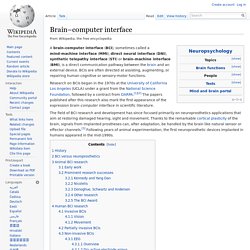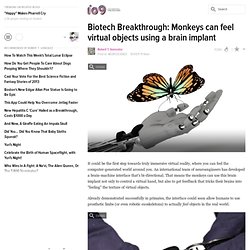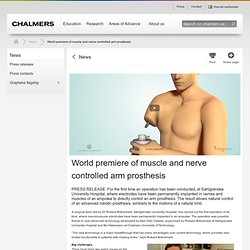

Interface neuronale directe. Un article de Wikipédia, l'encyclopédie libre.

Pour les articles homonymes, voir IND et BCI. Schéma d'une interface neuronale directe Une interface neuronale directe - aussi appelée IND ou BCI[1] (Brain-Computer Interface : Interface Cerveau-Machine, ou encore Interface Cerveau-Ordinateur) est une interface de communication directe entre un cerveau et un dispositif externe (un ordinateur, un système électronique, etc.). Ces systèmes peuvent être conçus pour assister, améliorer ou réparer des fonctions humaines de cognition ou d'action défaillantes. L'IND peut être unidirectionnelle ou bidirectionnelle. Ce type de périphérique est fondamentalement différent de toute autre interface homme-machine : une telle liaison ne requiert en effet aucune transformation préalable du signal électrique émis par l’activité cérébrale en activité musculaire (psychomotrice), cette dernière étant usuellement traduite en signal d’entrée pour la machine.
Principe[modifier | modifier le code] Un rapport conclu : Wearable ‘neurocam’ records scenes when it detects user interest. (Credit: Neurowear) Keio University scientists have developed a “neurocam” — a wearable camera system that detects emotions, based on an analysis of the user’s brainwaves.

The hardware is a combination of Neurosky’s Mind Wave Mobile and a customized brainwave sensor. The algorithm is based on measures of “interest” and “like” developed by Professor Mitsukura and the neurowear team. Brain–computer interface. A brain–computer interface (BCI), sometimes called a mind-machine interface (MMI), direct neural interface (DNI), synthetic telepathy interface (STI) or brain–machine interface (BMI), is a direct communication pathway between the brain and an external device.

BCIs are often directed at assisting, augmenting, or repairing human cognitive or sensory-motor functions. Research on BCIs began in the 1970s at the University of California Los Angeles (UCLA) under a grant from the National Science Foundation, followed by a contract from DARPA.[1][2] The papers published after this research also mark the first appearance of the expression brain–computer interface in scientific literature. The field of BCI research and development has since focused primarily on neuroprosthetics applications that aim at restoring damaged hearing, sight and movement.
History[edit] Berger's first recording device was very rudimentary. BCI versus neuroprosthetics[edit] Animal BCI research[edit] Early work[edit] 2013: M. 'Mind-reading' software could record your dreams - tech - 12 December 2008. Pictures you are observing can now be recreated with software that uses nothing but scans of your brain.

It is the first "mind reading" technology to create such images from scratch, rather than picking them out from a pool of possible images. Earlier this year Jack Gallant and colleagues at the University of California, Berkeley, showed that they could tell which of a set of images someone was looking at from a brain scan. To do this, they created software that compared the subject's brain activity while looking at an image with that captured while they were looking at "training" photographs. The program then picked the most likely match from a set of previously unseen pictures. Now Yukiyasu Kamitani at ATR Computational Neuroscience Laboratories in Kyoto, Japan has gone a step further: his team has used an image of brain activity taken in a functional MRI scanner to recreate a black-and-white image from scratch.
Dream catcher. Biotech Breakthrough: Monkeys can feel virtual objects using a brain implant. As long as they figure out which areas to stimulate those problems can be solved with neuro-optics.

It works by inserting a gene into the target neurons that makes them fire when exposed to a specific frequency of light. So instead of having to physically insert pieces of metal into the brain they place small laser diodes on the outside of the brain and fire them through the intervening tissue without actually harming it. Since no parts of the device is in direct contact with the brain it can be replaced, or upgraded, without worrying about permanently damage to the brain itself. Someone is already well underway with a "brain pacemaker" for schizophrenics that utilities the principle. Been successfully done in animals, but obviously anything that requires genetic engineering of neurons obviously have to make their way through a couple miles of red tape before they can even be tried on humans, so they have still barely entered human testing afaik.
Still, it's a very promising technology. A sensational breakthrough: the first bionic hand that can feel - News - Gadgets & Tech. The patient is an unnamed man in his 20s living in Rome who lost the lower part of his arm following an accident, said Silvestro Micera of the Ecole Polytechnique Federale de Lausanne in Switzerland.

The wiring of his new bionic hand will be connected to the patient’s nervous system with the hope that the man will be able to control the movements of the hand as well as receiving touch signals from the hand’s skin sensors. Dr Micera said that the hand will be attached directly to the patient’s nervous system via electrodes clipped onto two of the arm’s main nerves, the median and the ulnar nerves. This should allow the man to control the hand by his thoughts, as well as receiving sensory signals to his brain from the hand’s sensors. It will effectively provide a fast, bidirectional flow of information between the man’s nervous system and the prosthetic hand. “This is real progress, real hope for amputees. “The idea would be that it could deliver two or more sensations. World premiere of muscle and nerve controlled arm prosthesis. A surgical team led by Dr Rickard Brånemark, Sahlgrenska University Hospital, has carried out the first operation of its kind, where neuromuscular electrodes have been permanently implanted in an amputee.

The operation was possible thanks to new advanced technology developed by Max Ortiz Catalan, supervised by Rickard Brånemark at Sahlgrenska University Hospital and Bo Håkansson at Chalmers University of Technology. “The new technology is a major breakthrough that has many advantages over current technology, which provides very limited functionality to patients with missing limbs,” says Rickard Brånemark. Big challengesThere have been two major issues on the advancement of robotic prostheses: 1) how to firmly attach an artificial limb to the human body; 2) how to intuitively and efficiently control the prosthesis in order to be truly useful and regain lost functionality.